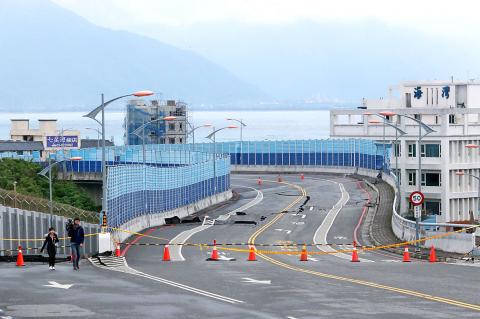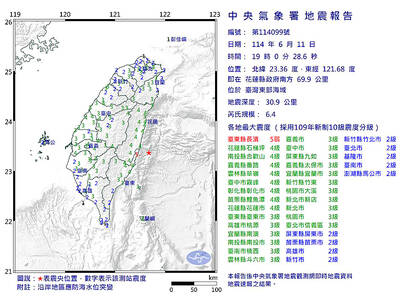The National Center for Research on Earthquake Engineering yesterday called for new laws to encourage the reconstruction of weaker structures, following the partial collapse of four buildings during Tuesday’s earthquake in Hualien.
The magnitude 6 earthquake, which occurred at 11:50pm on Tuesday, 18.3km northeast of Hualien County Hall, had an output level of 7 on the Modified Mercalli Intensity at its strongest point and caused damage to several structures, including two bridges and multiples buildings.
The Marshal Hotel suffered the most damage and was left leaning to one side after its bottom three floors crumpled.

Photo: CNA
At yesterday’s Lunar New Year-end news conference held by the Ministry of Science and Technology, center director-general Huang Shih-chien (黃世建) said the hotel, like structures that collapsed in previous earthquakes, was built before 1999 when stricter building code regulations were introduced.
This, combined with its proximity to the closest fault line, led to its collapse, Huang said.
Often these buildings have large open spaces in their ground floors, making them more prone to collapse, he said.
This is further exacerbated by the occupation of upper floors by residents, he said, adding that pillars or additional walls should be used to provide better structural support.
One of the issues stalling the reinforcement or reconstruction of older buildings is the large number of people who have property rights in the buildings.
Legal regulations governing the reconstruction process should be simplified, he added.
“If a consensus cannot be reached to move forward with reconstruction, I suggest property owners start with incremental, structural reinforcement,” he said, adding that owners of buildings with combined commercial and residential occupation be prohibited from making upper floors of their buildings publicly available until passing earthquake-resilience assessments.
Building Safety Certification Association director-general Tai Yun-fa (戴雲發) said reinforcements would not be enough and that older buildings must be reconstructed.
The Marshal Hotel had already undergone reinforcements, but was still unable to withstand a strong earthquake, he said, adding that the problem lay with its irregular facade and arcade-style architectural design.
Comparing the hotel with the collapse of the Weiguan Jinlong complex in Tainan during the earthquake on Feb. 6, 2016, Tai said that the latter differed in that its layout was not well designed.
The U-shaped design of that building, along with the use of poor-quality building materials, led to its collapse, he said.
Meanwhile, Huang said the center is capable of predicting an earthquake between five and 10 seconds in advance.
High-tech industry operators, including Taiwan Semiconductor Manufacturing Co and United Microelectronics Corp, should network their systems with the center to allow shutdown of equipment in the event of an earthquake, he said, adding this could prevent sensitive systems from damage.
The Taiwan High Speed Rail Corp is already networked with the center, he said.

STAY AWAY: An official said people should avoid disturbing snakes, as most do not actively attack humans, but would react defensively if threatened Taitung County authorities yesterday urged the public to stay vigilant and avoid disturbing snakes in the wild, following five reported snakebite cases in the county so far this year. Taitung County Fire Department secretary Lin Chien-cheng (林建誠) said two of the cases were in Donghe Township (東河) and involved the Taiwan habus, one person was bit by a Chinese pit viper near the South Link Railway and the remaining two were caused by unidentified snakes. He advised residents near fields to be cautious of snakes hiding in shady indoor areas, especially when entering or leaving their homes at night. In case of a

A magnitude 6.4 earthquake struck off the coast of Hualien County in eastern Taiwan at 7pm yesterday, the Central Weather Administration (CWA) said. The epicenter of the temblor was at sea, about 69.9km south of Hualien County Hall, at a depth of 30.9km, it said. There were no immediate reports of damage resulting from the quake. The earthquake’s intensity, which gauges the actual effect of a temblor, was highest in Taitung County’s Changbin Township (長濱), where it measured 5 on Taiwan’s seven-tier intensity scale. The quake also measured an intensity of 4 in Hualien, Nantou, Chiayi, Yunlin, Changhua and Miaoli counties, as well as

Credit departments of farmers’ and fishers’ associations blocked a total of more than NT$180 million (US$6.01 million) from being lost to scams last year, National Police Agency (NPA) data showed. The Agricultural Finance Agency (AFA) said last week that staff of farmers’ and fishers’ associations’ credit departments are required to implement fraud prevention measures when they serve clients at the counter. They would ask clients about personal financial management activities whenever they suspect there might be a fraud situation, and would immediately report the incident to local authorities, which would send police officers to the site to help, it said. NPA data showed

ENERGY RESILIENCE: Although Alaska is open for investments, Taiwan is sourcing its gas from the Middle East, and the sea routes carry risks, Ho Cheng-hui said US government officials’ high-profile reception of a Taiwanese representative at the Alaska Sustainable Energy Conference indicated the emergence of an Indo-Pacific energy resilience alliance, an academic said. Presidential Office Secretary-General Pan Men-an (潘孟安) attended the conference in Alaska on Thursday last week at the invitation of the US government. Pan visited oil and gas facilities with senior US officials, including US Secretary of the Interior Doug Burgum, US Secretary of Energy Chris Wright, Alaska Governor Mike Dunleavy and US Senator Daniel Sullivan. Pan attending the conference on behalf of President William Lai (賴清德) shows a significant elevation in diplomatic representation,